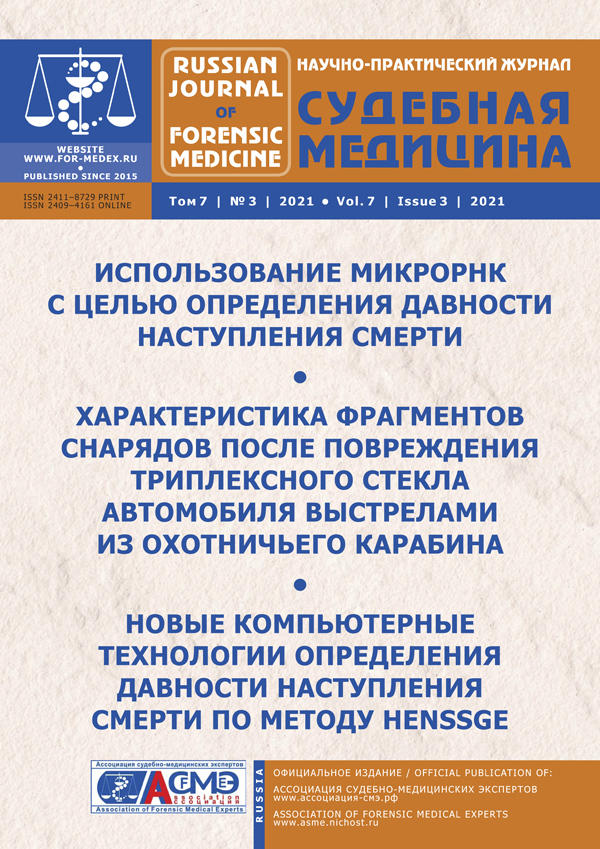Gunshot missile caliber and type estimation using superposition method by exit gunshot cranial vault fracture
- Authors: Semyonov V.V.1, Tsiatsiuyev A.M.1
-
Affiliations:
- Belarussian State Medical University
- Issue: Vol 7, No 3 (2021)
- Pages: 180-185
- Section: Case reports
- URL: https://bakhtiniada.ru/2411-8729/article/view/122453
- DOI: https://doi.org/10.17816/fm394
- ID: 122453
Cite item
Full Text
Abstract
A case of missile group identification by comparative examination using the image superposition method is presented. Identification was carried out using a skeletonized body vault exit gunshot fracture. The exit gunshot buttonhole fracture shape and dimensions reflected the bullet caliber and its flank profile. The entrance injury located on the anterior arch of the first cervical vertebra and the basilar part of the occipital bone, in this case, had no identification significance.
Full Text
##article.viewOnOriginalSite##About the authors
Vyachaslav V. Semyonov
Belarussian State Medical University
Author for correspondence.
Email: vjach_ws@mail.ru
ORCID iD: 0000-0002-6106-1806
SPIN-code: 1298-4821
Senior lecturer
Belarus, 220116, Minsk, Dzerzhinsky ave., 83Andrei M. Tsiatsiuyev
Belarussian State Medical University
Email: atetyuev@gmail.com
ORCID iD: 0000-0001-9240-2661
SPIN-code: 2088-8111
MD, Cand. Sci (Med.); Assistant Professor
Belarus, 220116, Minsk, Dzerzhinsky ave., 83References
- Molchanov VI, Popov VL, Kalmykov KN. Gunshot injuries and their forensic medical examination: a guide for doctors. Leningrad: Medicine; 1990. 270 p. (In Russ).
- Popov VL, Shigeev VB, Kuznetsov LE. Forensic ballistics. Saint Petersburg: Hippocrates; 2002. 656 p. (In Russ).
- Delannoy Y, Colard T, Le Garff E, et al. The mechanism of the keyhole lesion reassessed: An experimental approach. J Forensic Leg Med. 2015;37:1–7. doi: 10.1016/j.jflm.2015.09.020
- Marais A, Herman D. Utilization of X-ray computed tomography for the exclusion of a specific caliber and bullet type in a living shooting victim. J Forensic Sci. 2019;64(1): 264–269. doi: 10.1111/1556-4029.13805
- Kryukov VN. Mechanics and morphology of fractures. Moscow: Medicine; 1986. 156 p. (In Russ).
- Kryukov VN. Fundamentals of mechanical and morphogenesis of fractures. Moscow: Folium; 1995. 230 p. (In Russ).
- Kustanovich SD. Forensic medical trasology. Moscow: Medicine; 1975. 168 р. (In Russ).
- Paschall A, Ross AH. Bone mineral density and wounding capacity of handguns: implications for estimation of caliber. Int J Legal Med. 2017;131(1):161–166. doi: 10.1007/s00414-016-1420-6
- Shadymov AB. Features of forensic medical examination of gunshot bullet injuries of the cerebral skull. Forensic Medical Examination. 2000;43(1):14–19. (In Russ).
- Dubrovin I. Forensic medical assessment of gunshot fractures of flat bones. LAP LAMBERT Acad. Publ.; 2017. 220 р. (In Russ).
- DiMaio VJ. Gunshot wounds. Practical aspects of firearms, ballistics, and forensic techniques. 3rd ed. CRC Press; 2016. 378 р.
- Wim K, Erwin M, Evelien Z, Oostra R. Relationship between bullet diameter and bullet defect diameter in human calvariums. Int J Leg Med. 2020;134(1):267–272. doi: 10.1007/s00414-019-02197-9
- Berryman HE. A systematic approach to the interpretation of gunshot wound trauma to the cranium. Forensic Sci Int. 2019; 301:306–317. doi: 10.1016/j.forsciint.2019.05.019
- Leonov SV, Mikhailenko AV. Morphological signs of gunshot injuries of flat bones, allowing to determine the direction of rotation of a firearm projectile. Medical Expertise and Law. 2014;1:35–38. (In Russ).
- Dmitriev EI, Ivanov PY, Zudin SI. Investigation of objects of forensic examinations by methods of digital image processing: a textbook. Moscow: GU ECC of the Ministry of Internal Affairs of Russia, 2000. 80 р. (In Russ).
- Medical and forensic identification. The handbook of the forensic medical expert. Ed. by V.V. Tomilin. Moscow: NORMA-INFRA; 2000. 472 p. (In Russ).
- Shashkin SB, Vorobyev SA. Automation of comparison by the method of overlay in the technical and forensic examination of documents. Expert Practice. 2000;(49):22–30.
Supplementary files













